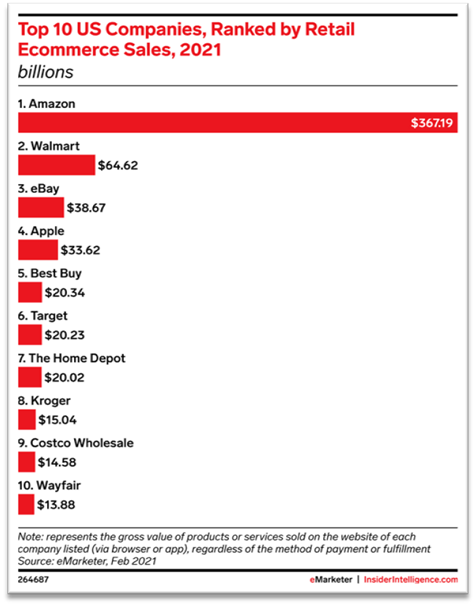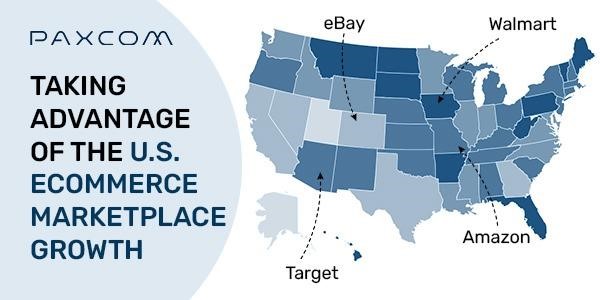For the past several years, online marketplaces have been the talk of the consumer industry, yet many brands struggle to gain a foothold in these outranked markets. Considering that U.S. eCommerce marketplaces are the second largest in the world. Each year, Amazon, eBay, and Etsy grow in popularity, driven by significant changes in consumer behavior.
Even though marketplaces offer an extensive reach of customers, but they differ significantly in terms of their requirements, entry fees, listings, pricing, guidelines, and range of audiences. Make sure you understand the nuances of everything before jumping on the marketplace selling bandwagon.
It sounds complex and time-consuming to streamline and optimize so many things, right? Don’t worry; there are more pros than cons- stay with us for a while.
Table of Contents
So, why sell on U.S. eCommerce Marketplaces?
The power of marketplaces lies in their ability to broaden consumer reach. Sellers can reach an estimated 3 billion monthly visitors through Amazon, Walmart, and eBay alone, according to Statista.

In order to reach new potential customers who are searching and interested in purchasing their products, merchants can list their products on multiple marketplaces. For instance, 63% of online shoppers begin their search for products on Amazon.
The Amazon Marketplace does offer not only built-in audience benefits but also various established programmes from selling and fulfillment to marketing—for example, Amazon Seller Hub, Amazon FBA, and eBay Seller Hub. The fulfillment options allow merchants to have the marketplaces pick, pack, and ship inventory for them.
The ability to begin selling quickly is another significant benefit of selling on marketplaces. Once a merchant gets approval, listing products is as easy as uploading something on a product feed.
How to win with the U.S. eCommerce marketplaces?
1. Create a buyer persona for customer segmentation
Buyer personas help you put flesh and bones on the people in your target audience. They help you more clearly understand our ideal customers so that you can more effectively market to them.
Attributes for Building Buyer Personas-
- Age
- Gender
- Geolocation
- Purchasing power
Why do Buyer Personas Matter?

When you create personas, you start identifying the motivations of buyers based on their professions, lifestyles, or, in this case, the site they prefer to shop on, rather than viewing buyers as one general group.
By understanding each persona’s expectations, you can write content that resonates more deeply and identify the best marketing opportunities for your brand. This ultimately leads to higher conversion rates. With this, you can go beyond the cookie-cutter approach, seize the opportunity to meet customer expectations, and hit just the right point.
2. Customer Roadmap
All the customer’s brand interactions and touchpoints with your brand from start to finish are part of the customer journey. They may become aware of a problem, conduct informational research, read your product page, and engage with your social media profiles. Additionally, it includes their first purchase and ongoing interactions.
Knowing the customers’ journey can help you identify where customers are spending their time and interact with it, whether it be your product detail page, CPC ads, or event promotions. With this, you can optimize your strategy on each touchpoint and give customers exactly what they want.
3. Position your brand with competitive pricing

When a company tries to convince customers to buy a product or service, its pricing position is essential. If a brand intends to sell low-priced smartphones, it needs to keep its prices low enough to match its positioning. If a brand wants to be seen as high-end or luxurious, it needs to charge accordingly.
For example, in the U.S. eCommerce marketplace, Walmart is known for its low-priced value services. If your product falls under that category, your ability to drive sales increases by 3X, and you also improve your visibility.
Having a competitive price position makes the product stand out from its competitors. Adding to that, a brand’s price position is ideal when a brand can charge higher prices and keep the competitors at bay.
4. Fulfillment services to manage stock management

Online marketplaces entail a higher expectation of speedy delivery than direct-to-consumer (D2C) websites. So, the dilemma is: either you can self-fulfill, or you can use the fulfilment services offered by the marketplace.
Fulfillment services for U.S. eCommerce marketplaces like Amazon FBA, eBay’s Orange Connex, and Walmart’s WFS allow you to get your products delivered in a short period of time. The hassle of packaging, storing, and shipping is reduced. All you have to do is send your inventory to a Fulfillment Center (FC).
However, it often depends on your brand’s capabilities in its supply chain and capacity. If your supply chain is strong and you have the tools to keep track of SKUs and manage them, you can always opt out of self-fulfillment.
If you meet customers’ convenience needs and demands, profits and reach won’t wane.
5. Ensure Retail Readiness
When it comes to organic ranking and reach, nothing beats optimizing your product listing on the eCommerce marketplaces. You need to ensure that you tick mark all the information criteria that are required to be put forth on the PDP page, from SEO-rich titles, HD images, product descriptions, specifications, and enhanced content.
An accurate digital catalog also contributes to retail readiness. You get what you put in. In addition, automated product-receive processes in warehouses may go awry when the product data is incorrect, causing delays and out-of-stocks.
Loyalty to a single channel is a thing of the past. Today’s customers shop and make decisions across multiple marketplaces, expecting consistency in your brand packaging, voice, images, etc.
6. Perfect your marketing campaigns and activities
There is no standard strategy when every platform offers different advertising services when it comes to U.S. eCommerce marketplaces. So, align your campaigns that fit with your business goal, budget, time, and target audience.
For example, run ads on and off Amazon, Utilize Walmart Connect; eBay, too, has a sophisticated platform that does not offer customization like Amazon and other giant platforms, but can help you reach your target customers.
Ask questions to yourself?
- Where are your customers spending time?
- Where should you run ads? Do they like video ads or banner ads?
- Do they want gamification, quizzes, or promotions, deals & discounts from you?
To achieve that, you need to allocate some budget your ad spends to get the ROI you want; while we will get to the data part- but in order to gather data for optimization, you need to partake in A/B testing to get things moving and learn the insights you would want.
Our E-commerce experts can also help with end-to-end campaign management in sync with your Brand’s goals and objectives across all platforms and channels.
7. Data=informed decisions

The benefit of selling on U.S. eCommerce marketplaces is the data the platforms provide—the pool of endless data. Since you will be up and running advertisements, promotions, and A/B testing on prices, data will act as a catalyst to further fine-tune your strategies.
Data will provide you answers on-
- Is my growth being driven by a particular platform, and which platform do I want to drive growth on?
- How do I measure my profitability in each market?
- How can I target my advertising most effectively?
From pricing, keyword optimization, and stock levels, you will have all the necessary insights—for example, dead turns, campaign performance, etc. The problem is that tracking so many KPIs can get overwhelming, especially when you are selling on more than one platform—a centralized solution would be helpful.
How Can Data Help?
Scenario 1- (Walmart)

When the 90-Day order defect rate goes up; you will see an increase in the number of daily or weekly average reviews, and the sentiments behind it may redirect you to identify a common theme and offer you a chance to improve your product and as well show you care for your customers by providing a replacement and avoid recurring issues.
Scenario 2- (Amazon.com)
Suppose, for instance, a brand on Amazon reaches a plateau in sales; in terms of PPC (the brand has fully utilized SP and SB), the next step would be to start using DSP ads, which are on top of the funnels and even above SD.
The brand decided, however, before reaching the top funnel, to run SD campaigns to accumulate as much data as possible from SD campaigns, such as running every possible pilot campaign. By leveraging that insight and using analytical data, the launch of the DSP will be more successful, and ultimately, some costs can be saved.
Our eCommerce analytics tool, Kinator, helps brands make sound, strategic decisions by combining any data available into an interactive and visual format. Dashboard features include the ability to filter by Channel, Category, Brand, Focus SKU, Timeframe, Zipcodes, and more, and can be accessed at any time. You gain access to high-end information about consumer behavior, and all the major KPIs to tailor marketing and sales strategies specifically to meet your needs, resulting in increased sales.
Final Thoughts
Online eCommerce marketplaces provide a wide range of value-added services and products to consumers. Consumers rely increasingly on marketplaces for product searches and other conveniences. For brands to establish the best positioning, they should be clear about what differentiates their products or services. If you are not already on board, now is the time to enter the marketplace and test the waters. If you are already established, it’s time to throw in some modern strategies to your traditional ones. Because, if eCommerce itself is dynamic, think about how consumers would be.
If you’re interested in learning more about our tool and how it can fit in with your existing marketing strategies, you can reach out to us at info@paxcom.net.














